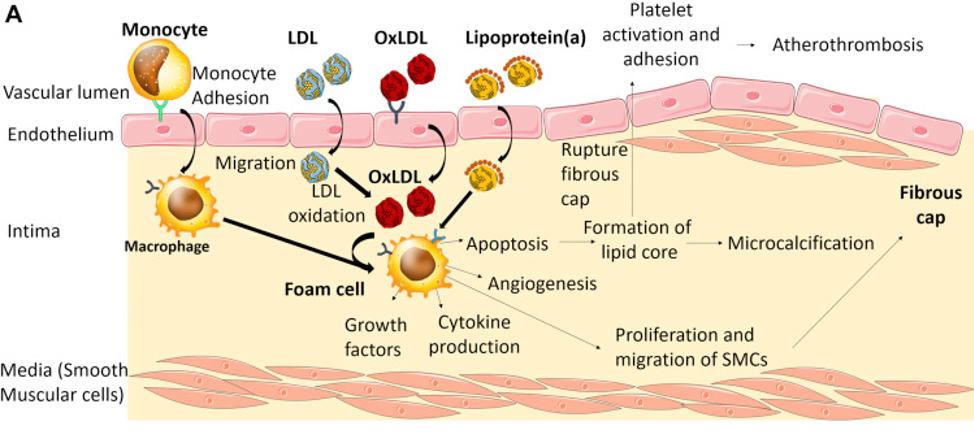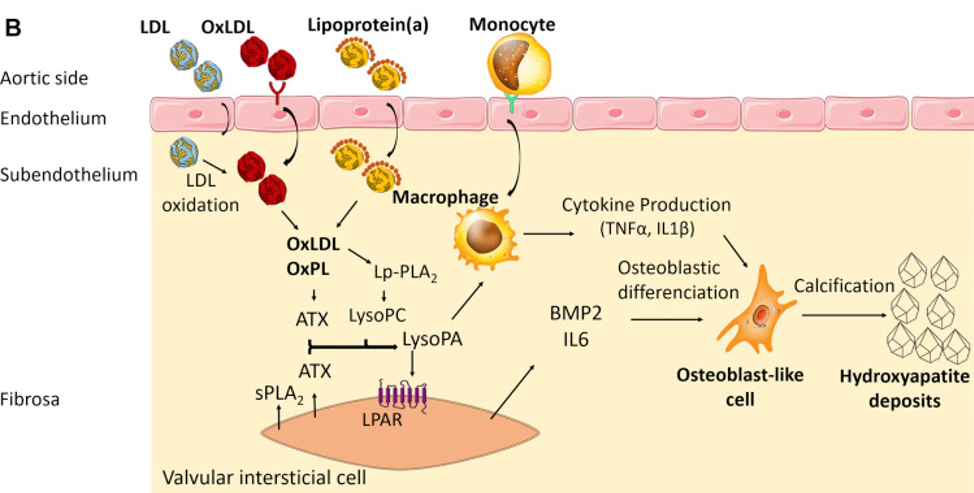Decades of research into cardiovascular risk factors have provided substantial evidence of the causal role of lipoproteins containing Apolipoprotein B in the pathophysiology of cardiovascular disease, such as coronary heart disease, calcific aortic valve stenosis (CAVS), and stroke.
The only way a cholesterol particle may infiltrate the arterial wall is if an LDL lipoprotein puts it there, and that’s why LDL cholesterol is considered “the bad guy.” This accumulation leads to an oxidative process, with the consequent inflammation, which we now know is the origin of the disease. Our immune system reacts, sending out macrophages that engulf and digest oxidized cholesterol, thus increasing in size.
Dr. Alfonso Galán González – Neolife Medical Team
LDL oxidation is the first event that occurs in the formation of the foam cells of the plaque of atheroma, and the LDL in arterial lesions is highly oxidized.
Decades of research into cardiovascular risk factors have provided substantial evidence of the causal role of lipoproteins containing Apolipoprotein B in the pathophysiology of cardiovascular disease, such as coronary heart disease, calcific aortic valve stenosis (CAVS), and stroke.
This evidence currently supports the idea that lowering the number of particles containing Apo-B leads to beneficial effects at the cardiovascular level. Most of these lipoproteins are, of course, LDL.
For educational purposes, let’s briefly and simply review a number of concepts. Cholesterol is a vital compound for the body. Our cells are covered with a membrane made up mainly of fat and cholesterol. Cholesterol is essential for proper brain function, is the basis for synthesizing sex hormones and vitamin D, and is also a key compound for bile, which helps us digest fats. This cholesterol must be carried by the bloodstream from where it’s synthesized and absorbed to wherever it has to be used, and it does this while packaged in lipoproteins.
LDL (low-density lipoprotein) is responsible for bringing cholesterol to the cells, and HDL (high-density lipoprotein) collects excess cholesterol to return to the liver.
Atherosclerosis begins when cholesterol infiltrates the walls of an artery, its innermost layer, the endothelium, triggering a series of inflammatory processes that may lead to plaque buildup and potentially, over time, to the blockage of the artery.
The only way a cholesterol particle may infiltrate the arterial wall is if an LDL lipoprotein puts it there, and that’s why LDL cholesterol is considered “the bad guy.” This accumulation leads to an oxidative process, with the consequent inflammation, which we now know is the origin of the disease. Our immune system reacts, sending out macrophages that engulf and digest oxidized cholesterol, thus increasing in size.
What is, then, the relationship between LDL cholesterol and cardiovascular disease?
Although LDL cholesterol levels may predict cardiovascular events, the “penetrance” of elevated cholesterol is far from perfect. In other words, cardiovascular events occur in individuals with normal LDL that are not undergoing treatment, while there are others with very high levels who don’t suffer from cardiovascular disease.
However, we must clarify that this is attributable to the presence of other risk factors (smoking, high blood pressure, type 2 diabetes, bad nutritional habits, sedentary lifestyle, obesity, Lp (a)..), as well as other factors involved.
And so, there is a huge variability from individual to individual and between LDL particles, and it has been shown that smaller, denser LDLs predict cardiovascular risk in the general population.
Risk factors for oxidized LDL include:
- Diets that are rich in trans fats
- Smoking
- Poorly managed diabetes
- Metabolic syndrome
- Exposure to toxins through pollution and preservatives
- Stress
Interestingly, the factors that may explain that there are differences between cardiovascular risk with different LDL values are those that cause us to have more oxidized LDL (OxLDL).
We know that LDL oxidation is the first event that occurs in the formation of the foam cells of the plaque of atheroma(these macrophages that are increased in size), and that the LDL in arterial lesions is highly oxidized (1).
The process of oxidation of lipids and proteins is the result of an excess of free radicals and other oxygen and nitrogen oxidizing species. Oxidative stress is associated with an increase in the production of oxidizing species or a decrease in antioxidant defenses.
There is currently clear evidence that LDL oxidation plays a significant role in atherogenesis. There are over 11,000 articles published on Pubmed on “Oxidized LDL”. This is because there is clear evidence that confirms that oxidative modification of LDL plays a key role in atherosclerosis, and this obviously makes it a target for therapeutic measures.
How does OxLDL contribute to the formation of atherosclerotic plaque?
The pathobiological mechanism by which they cause atherosclerosis and CAVS is the following:

LDL, OxLDL, and OxPLs (oxidized phospholipids) pass into the subendothelial space and are involved in the recruitment, activation, and proliferation of monocytes and macrophages. These activated macrophages or foam cells secrete growth factors that lead to the migration and proliferation of smooth muscle cells.
OxLDL and OXPL also stimulate platelet adhesion and aggregation, which may explain to some extent the thrombotic phenomena observed in advanced atherosclerosis.

OxLDL and LpA are also involved in the early stages of CAVS. This pathology is also triggered by the infiltration of OxLDL into the valve, which eventually induces the transition from valvular interstitial cells to osteoblasts (2).
So, should we measure OxLDL instead of LDL?
On the one hand, it’s not clear whether measuring OxLDL in plasma reflects its atherogenic capacity, as we know that a very significant portion of LDL oxidizes in the sub-intimate layer of the arteries producing effects in the vascular wall and not in the plasma. And on the other hand, we would need at least 3 conditions to be met:
- That the OxLDL predicts cardiovascular risk regardless of the established risk factors. In this regard, most of the studies included in a meta-analysis conducted by Gao et al. (3) have shown that this association between OxLDL and cardiovascular events was indeed independent of other risk factors.
- That measuring OxLDL allows us to reclassify individuals from to another risk category. In this regard, few studies have researched this; the REGICOR study (4) did indeed show that measuring OxLDL can improve this requalification rate in its sample of 2793 men and women.
- That making OxLDL our therapeutic target will lead to benefits at the cardiovascular level. Here, we need randomized clinical trials that show us this effect, in addition to having the ability to affect the number of these particles.
Trials with antioxidants (vitamins C, E, and carotene) have so far not provided convincing evidence of cardiovascular protection, although these studies were not designed to analyze the role of oxidized lipoproteins.
Another aspect to consider is that as mentioned, the biological relevance of OxLDL, OxPL, and Lp(a) occurs in the early stages of atherosclerosis and CAVS rather than in the final stages in which other mechanisms are already intervening.
Therefore, this seems to be very promising in the fight against atherosclerosis, and a great many of the efforts of the scientific community are aimed at answering the questions that still remain and creating drugs that specifically target these harmful particles.
BIBLIOGRAPHY
(1) E. Leiva, S. Wehinger, L. Guzmán and R. Orrego (September 17th 2015). Role of Oxidized LDL in Atherosclerosis, Hypercholesterolemia, Sekar Ashok Kumar, IntechOpen, DOI: 10.5772/59375. Available from: https://www.intechopen.com/books/hypercholesterolemia/role-of-oxidized-ldl-in-atherosclerosis
(2) Do Oxidized Lipoproteins Cause Atherosclerotic Cardiovascular Diseases? Arsenault, Benoit J. et al. Canadian Journal of Cardiology, Volume 33, Issue 12, 1513 – 1516
(3) Gao S, Zhao D, Wang M, et al. Association between circulating oxidized LDL and atherosclerotic cardiovascular disease: a meta-analysis of observational studies. Can J Cardiol 2017;33:1624-32.
(4) Gómez M, Vila J, Elosua R, et al. Relationship of lipid oxidation with subclinical atherosclerosis and 10-year coronary events in general population. Atherosclerosis 2014;232:134-40.
